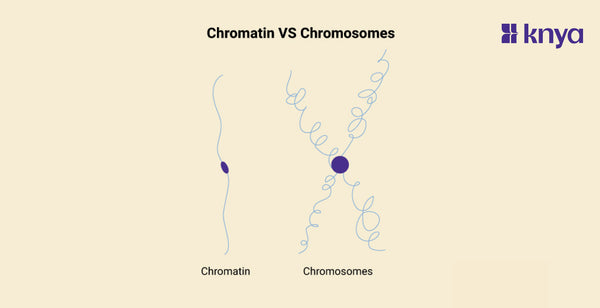Difference Between Chromatin and Chromosomes: Imagine DNA as a library's worth of knowledge, way too hefty to hold at once. Chromatin is like the carefully organised bookshelves, compacting DNA and proteins into manageable strands. These strands then spiral further to form individual chromosomes, the sturdy "packages" of genetic information passed down during cell division, like numbered binders storing specific volumes of the library. Chromatin isn't just storage, though; it also controls access to the "books" (genes), regulating which instructions get read and when. So, chromatin and chromosomes are both crucial for keeping this precious library organised, accessible, and ready to guide the cell's activities.
Difference between Chromatin and Chromosomes
The phrases chromatin and chromosomes refer to the organisation of genetic material within a cell. Listed are several differences between chromatin and chromosomes.
|
Feature |
Chromatin |
Chromosomes |
|
Structure |
Complex of DNA, RNA, and proteins |
Condensed and organized DNA structure |
|
Condensation Level |
Relatively less condensed |
Highly condensed during cell division |
|
Visibility |
Not visible during interphase |
Visible under a microscope during division |
|
Function |
Gene expression, DNA replication, repair |
Facilitates accurate segregation during division |
|
Cell Cycle Presence |
Present throughout the cell cycle |
Visible mainly during cell division |
|
Number in a Cell |
Multiple chromatin fibers per cell |
Specific number for a species during division |
|
Composition |
DNA, histones, and proteins |
Tightly coiled DNA and associated proteins |
|
Transcription Activity |
Allows active gene expression |
Limited during cell division |
|
Location |
Found in the cell nucleus |
Also in the cell nucleus, more visible during division |
|
Role in Cell Division |
Participates in replication and repair |
Facilitates accurate segregation of genetic material |
What is Chromatin?
Chromatin is the dynamic, thread-like material that makes up chromosomes in eukaryotic cells. Think of it as DNA organized and packaged with proteins called histones, like beads on a string. This packaging not only compacts the long DNA molecules to fit within the nucleus, but also plays a crucial role in controlling gene expression. Chromatin can be loosely packed for gene access or tightly condensed for cell division.
Key Features of Chromatin:
- Packaging DNA: Chromatin is the complex of DNA and protein that snugly packages long DNA molecules into a compact, manageable form. Think of it as DNA wrapped around cozy protein "blankets" for storage and protection.
- Levels of Organization: Chromatin has multiple levels of organization. Nucleosomes are the basic units, where DNA wraps around protein cores like beads on a string. These beads then fold and loop into thicker fibers, ultimately forming chromosomes.
- Gene Regulation: Chromatin structure isn't just for packing; it also influences gene expression. Tightly packed chromatin makes genes inaccessible, while looser packing allows for gene activation. Imagine the protein blanket influencing how easily you access your belongings!
- Dynamic Structure: Chromatin isn't static; its structure changes throughout the cell cycle. During cell division, chromatin condenses further to form visible chromosomes, ensuring accurate segregation of genetic material. Think of the cozy blankets becoming tight sleeping bags for safe travel.
What are Chromosomes?
Chromosomes are the highly condensed and organized structures that contain genetic information. During cell division, chromatin condenses further to form the distinct X-shaped structures we see under a microscope. Each chromosome carries a single, long molecule of DNA and specific proteins that help ensure proper segregation during cell division. Humans have 23 pairs of chromosomes, with one set inherited from each parent.
Key Features of Chromosomes:
- DNA Carriers: Chromosomes are condensed structures of chromatin, containing a single linear DNA molecule and associated proteins. Imagine them as organized packages carrying the genetic instructions.
- Number and Shape: Humans have 46 chromosomes, typically arranged in 23 pairs. Each chromosome has a characteristic size and shape, allowing for easy identification during cell division. Think of them like uniquely labeled suitcases carrying specific genetic content.
- Cell Division Essentials: Chromosomes are crucial for cell division, ensuring each daughter cell receives a complete set of genetic material. During mitosis and meiosis, chromosomes replicate and segregate, ensuring proper inheritance. Imagine the suitcases carefully traveling to new homes during cell division.
- Genetic Variation: Chromosomal abnormalities, like missing or extra chromosomes, can lead to genetic disorders. Studying chromosomes helps diagnose genetic conditions and understand the role of specific genes in health and disease. Imagine identifying unique features of the suitcases to understand what they contain and potential issues they might carry.
Shop Best Lab Coats from Here!
Similarities Between chromatin and chromosomes
- DNA, which conveys genetic information, is found in both chromatin and chromosomes.
- In eukaryotic cells, both are located within the cell nucleus.
- Genetic Material: Both chromatin and chromosomes carry the genetic information required for an organism's growth and function.
- Dynamic Structure and Organisation: During various phases of the cell cycle, both chromatin and chromosomes undergo dynamic changes in their structure and organisation.
- Histone proteins are found in both chromatin and chromosomes and aid in the packing and organisation of DNA.
Imagine our genetic blueprint, DNA, as a vast library of information. Chromatin acts like the filing system, expertly packing and organizing the DNA into compact units called nucleosomes. These units then fold and loop further, forming a dynamic, thread-like structure that resides within the nucleus. Chromosomes, on the other hand, are the condensed, highly organized versions of chromatin that emerge during cell division, resembling tightly coiled cables. In essence, chromatin provides the fundamental packaging for DNA, while chromosomes represent its ultimate level of organisation for accurate copying and distribution during cell replication. While both are crucial for housing and managing our genetic material, the key difference lies in their level of compaction and visibility – chromatin being the dynamic workhorse behind the scenes, and chromosomes taking centre stage during cell division.















